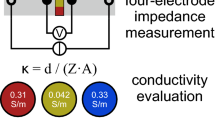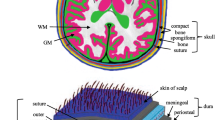Abstract
In this study, we consider different conductivity values based on tissue location in a human head model. We implement local conductivity (LC) to compute head surface potentials in three-, four-layered spherical and realistic head models using finite element method (FEM). Implementing LC for all head models, we obtain significant scalp potential variations in the term of relative difference measurement (RDM) and magnification (MAG) values with a maximum of 2.03 ± 1.81 and 8.27 ± 6.36, respectively. We also investigate the effects of conductivity variations (CVs) of head tissue layer on scalp potentials and find a maximum of 2.15 ± 1.93 RDM and 8.57 ± 6.61 MAG values. Our study concludes that it is important to assign LC to each tissue and it is also important to assign appropriate conductivity value in the construction of a head model for achieving accurate scalp potentials.




Similar content being viewed by others
References
Nicolas C, Xavier F, Florent A, Pierre C, Bernard R (2008) Critical imaging on head template: a simulation study using resistor mesh model (RMM). Brain Topogr 21:52–60
Bruno P, Vatta F, Inchingolo P (2001) Interaction between noise and lesion modeling errors on EEG source localization accuracy. In: Proceedings of the 23rd annual EMBS international conference, pp 917–920
Awada KA, Jackson DR, Baumann SB, Williams JT, Wilton DR, Fink PW, Prasky BR (1998) Effect of conductivity uncertainties and modeling errors on EEG source localization using a 2-D model. IEEE Trans Biomed Eng 45(9):1135–1145
Roche-Labarbe N, Aarabi A, Kongolo G, Gondry-Jouet C, Dumpelmann M, Grebe R, Wallois F (2008) High-resolution electroencephalography and source localization in neonates. Hum Brain Mapp 29:167–176
von Ellenrieder N, Muravchik CH, Nehorai A (2006) Effects of geometric head model perturbations on the EEG forward and inverse problems. IEEE Trans Biomed Eng 53(3):421–429
Bart Vanrumste B, Van Hoey G, Van de Walle R, DHave M, Lemahieu I, Boon P (2000) Dipole location errors in electroencephalogram source analysis due to volume conductor model errors. Med Biol Eng Comput 38:528–534
Schimpf PH, Ramon C, Haueisen J (2002) Dipole models for the EEG and MEG. IEEE Trans Biomed Eng 49(5):409–418
Makis N, Angelone L, Tulloch S, Sorg S, Kaiser J, Kennedy D, Bonmassar G (2008) MRI-based anatomical model of the human head for specific absorbtion rate mapping. Med Biol Eng Comput 46:1239–1251
Sadleir RJ, Argibay A (2007) Modeling skull electric properties. Ann Biomed Eng 35:1699–1712
Marin G, Guerin C, Baillet S, Garnero L, Meunier G (1998) Influence of skull anisotropy for the forward and inverse problem in EEG: simulation studies using FEM on realistic head models. Brain Mapp 6:250–269
Law SK (1993) Thickness and resistivity variations over the upper surface of the human skull. Brain Topogr 6:99–109
Ramon C, Haueisen J, Schimpf PH (2006) Influences of head models on neuromagnetic fields and inverse source localizations. BioMed Eng Online 5:55
Ramon C, Schimpf PH, Haueisen J (2006) Influences of head models on EEG simulations and inverse source localizations. BioMed Eng Online 5:10
Ramon C, Schimpf PH, Haueisen J (2004) Effect of model complexity on EEG source localizations. Neurol Clin Neurophysiol 81:1–3
Bashar MR, Li Y, Wen P (2008) Influence of white matter inhomogeneous anisotropy on EEG forward computing. Australas Phys Eng Sci Med 31(2):122–130
Haueisen J, Tuch DS, Ramon C, Schimpf PH, Wedeen VJ, George JS, Belliveau JW (2002) The influence of brain tissue anisotropy on human EEG and MEG. NeuroImage 15:159–166
Haueisen J, Ramon C, Brauer H, Nowak H (2000) The influence of local tissue conductivity changes on the magnetoencephalogram and the electroencephalogram. Biomed Tech 45:211–214
Haueisen J, Ramon C, Eiselt M, Brauer H, Nowak H (1997) Influence of tissue resistivities on neuromagnetic fields and electric potentials studied with a finite element model of the head. IEEE Trans Biomed Eng 44(8):727–735
Vatta F, Bruno P, Inchingolo P (2002) Improving lesion conductivity estimate by means of EEG source localization sensitivity to model parameter. Clin Neurophysiol 19(1):1–15
Ferree TC, Eriksen KJ, Tucker DM (2000) Regional head tissue conductivity estimation for improved EEG analysis. IEEE Trans Biomed Eng 47(12):1584–1591
Ni A, Xiuzhen D, Yang G, Fu F, Tang C (2008) Image reconstruction incorporated with the skull inhomogeneity for electrical impedance tomography. Comput Med Imaging Graph 32:409–415
Ollikainen JO, Vaukhonen M, Karjalainen PA, Kaipio JP (1999) Effects of local skull inhomogeneities on EEG source estimation. Med Eng Phys 21:143–154
He B, Wang Y, Wu D (1999) Estimating cortical potentials from scalp EEG’s in a realistically shaped inhomogeneous head model by means of the boundary element method. IEEE Trans Biomed Eng 46(10):1264–1268
Wen P (2000) Human head modelling and computation for the EEG forward problem. PhD dissertation, The Flinders University of South Australia, Australia
Wen P, Li Y (2006) EEG human head modelling based on heterogeneous tissue conductivity. Australas Phys Eng Sci Med 29(3):235–240
Shattuck DW, Sandor-Leahy SR, Schaper KA, Rottenberg DA, Leahy RM (2001) Magnetic resonance image tissue classification using a partial volume model. NeuroImage 13:856–876
Shattuck DW, Leahy RM (2002) BrainSuite: an automated cortical surface identification tool. Med Image Anal 8(2):129–142
Dogdas B, Shattuck DW, Leahy RM (2005) Segmentation of skull and scalp in 3-D human MRI using mathematical morphology. Hum Brain Mapp 26:273–285
Shattuck DW (2005) BrainSuite 2 Tutorial, online version. http://brainsuite.usc.edu
Gabriel S, Lau RW, Gabriel C (1996) The dielectric properties of biological tissues: III. Parametric models for the dielectric spectrum of tissues. Phys Med Biol 41:2271–2293
Wolters CH (2003) Influence of tissue conductivity inhomogeneity and anisotropy on EEG/MEG based source localization in the human brain. PhD dissertation, University of Leipzig, Germany
Si H (2004) TetGen. http://tetgen.berlios.de
Baillet S, Mosher JC, Leahy RM (2004) Electromagnetic brain imaging using brainstorm. In: IEEE international symposium on biomedical engineering: macro to nano, pp 652–655
Bashar MR, Li Y, Wen P (2008) Effects of white matter tissue conductivity on multi-layered spherical head model. In: IEEE proceedings of the international conference on electrical and computer engineering (ICECE’08), pp 59–64
Bashar MR, Li Y, Wen P (2009) EEG analysis on skull conductivity perturbations using realistic head model. Lect Notes Comput Sci 5589:208–215
Yan Y, Nunez PL, Hart RT (1991) Finite-element model of the human head: scalp potentials due to dipole sources. Med Biol Eng Comput 29:475–481
Baillet S, Mosher JC, Leahy RM (2001) Electromagnetic brain mapping. IEEE Signal Process Mag 18(6):14–30
Meijis JW, Weier OW, Peters MJ, van Oosterom A (1989) On the numerical accuracy of the boundary element method. IEEE Trans Biomed Eng 36(10):1038–1049
ASA Advanced Source Analysis, ANT software, The Netherland. www.ant-neuro.com
Nicolas C, Xavier F, Bernard D, Bernard R, Jean PM, Pierre C (2004) Effects of skull thickness, anisotropy, and inhomogeneity on forward EEG/ERP computations using spherical three-dimensional resistor mesh model. Hum Brain Mapp 21:86–97
Acknowledgment
This project is partially supported by Australian Research Council Discovery Program DP0665216.
Author information
Authors and Affiliations
Corresponding author
Rights and permissions
About this article
Cite this article
Bashar, M.R., Li, Y. & Wen, P. Effects of local tissue conductivity on spherical and realistic head models. Australas Phys Eng Sci Med 33, 233–242 (2010). https://doi.org/10.1007/s13246-010-0027-3
Received:
Accepted:
Published:
Issue Date:
DOI: https://doi.org/10.1007/s13246-010-0027-3




